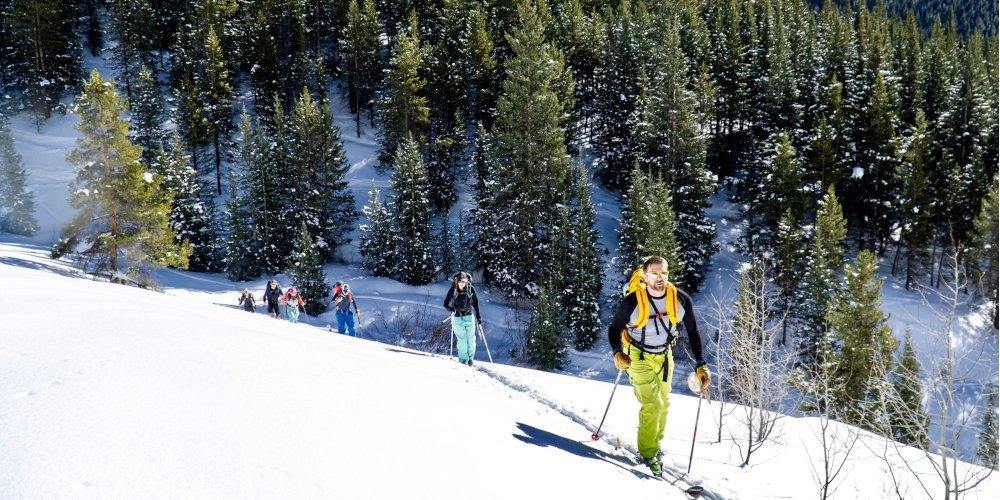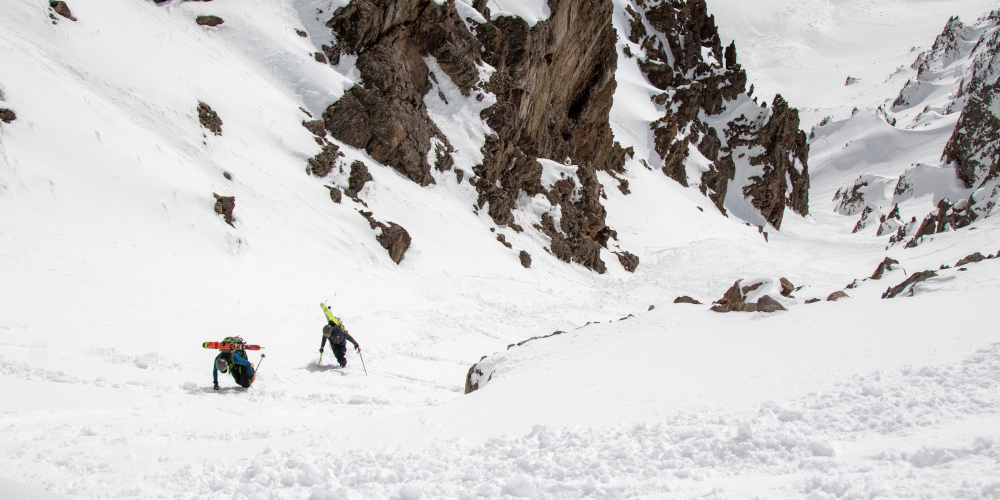So you want to ski in the backcountry, but what exactly does that mean?
You've overheard stories on the chairlift or at the local apres bar of deep powder stashes, unparalleled vistas and undisturbed solitude. You've pieced it together and you come to understand that these people are talking about skiing and riding outside of the ski area boundary in the 'backcountry'. Like any ski fanatic, you're intrigued, but not quite sure what all of this means. Worry no more, we're here to help. Here's a rundown of all the ways you can earn your turns or ski out of bounds.
Resort Ski Touring/Fitness
It’s January, the days are cold and dark, yet you still want to get a workout. What’s a skier to do? Increasingly, more and more winter recreationalists are taking to the groomed slopes of their closest ski resort for some in-bounds uphilling. There is a growing segment of the ski and snowboard user base that may never venture into avalanche terrain, but love the idea of earning their turns. All over the country, resorts are opening their slopes to these athletes, some for limited morning and evening time slots, others at all hours.
Want to start resort uphilling? The first step here is to consult with your local ski patrol or resort web site for their uphill policy. Some have an open access program, while others require signing a waiver or even purchasing an inexpensive access pass. Cripple Creek has stores in both Aspen and Vail which both have uphill policies, not to mention our our staff and customers regularly access the slopes with their touring gear. This incredible benefit is sometimes accessed alone, other times for nighttime full moon group events or early-morning social meet ups.
In addition to being convenient and easily accessible, resort uphilling also provides the added benefit of being within controlled terrain, so no avalanche safety gear is required. This, of course, only applies during the ski season when patrol is working the terrain. Once the resorts close in the spring, these zones also become backcountry terrain and safety gear is recommended! Check out this article for things to be aware of when touring inbounds.
Be sure to check out our events page to see our schedule of group skins!

Resort skinning adds a new realm of possibilities (PC: Jack Affleck)
Resort Accessed Backcountry AKA Sidecountry
While all of those lifts provide access to thousands of acres of in-bounds terrain, what about the stuff that lies on the other side of the rope? Resort accessed backcountry, or 'sidecountry' refers to backcountry skiing you can ride a lift to access. Sometimes it's as simple as exiting through that gate with the ‘you could die beyond this point’ sign and skiing down. In other instances it requires a short hike to get to the top of your line.
So you ride the lift up, exit through a gate, and maybe even return to the resort? Wait, that sounds like Utopia! However, just like the most remote backcountry destinations, the sidecountry has one important thing in common: it’s wild, uncontrolled, and just as prone to avalanche danger. So regardless of the accessibility, or the increased amount of skier traffic relative to other backcountry areas, any time you set foot outside of the resort you are entering uncontrolled and unpredictable terrain. Just because you pass a ski patrol shack on your way out to these more easily accessed goods, that doesn’t mean that their rescue services are available in the event of an accident.
While the dangers are certainly present, there is a reason why hoards of skiers enjoy this type of terrain. You can utilize the modern wonder that is a chairlift to knock out 2,000-4,000 vertical feet, then tour a short (or long) distance to enjoy all of our favorite things about the backcountry. Then, you return to civilization and possibly even to the resort for another chairlift-served lap in the same day. At many resorts, this has become just another part of a local’s day on the hill. Places like Telluride, Aspen, Vail, Jackson Hole, Alpine Meadows you’ll see folks with backpacks headed out gates in search of something more.
Before you jump into making plans to hop out of one of these gates on your next ski vacation, we encourage you to take caution. As we stated above, these locales can be no less dangerous than the most remote peaks, and rescue services just as challenging. One option is to engage the services of a local guide service. They know the routes, they know the conditions, and they can get you home safely, which takes us to the essential rule of skiing: live to ski another day!

You can get to some pretty amazing places with your own two feet (PC: Aidan Goldie)
Human-Powered Backcountry
When most people refer to 'backcountry skiing', 'uphill skiing', 'ski touring',etc. this is what they are talking about. In human-powered backcountry skiing, 100% off the vertical and turns you earn are under the power of your own two legs. For many, the essence of backcountry skiing and snowboarding has always been the human-powered experience.
Leave the trailhead with your skis on your feet and your gear on your back, whether for a few hours or a few days, and get away from it all for some turns in fresh powder or warm spring corn. Follow a well-known summer trail to visit that alpine lake basin that you’ve only seen covered in wildflowers, or farm low-angle powder turns on a sunny winter day with friends, the backcountry tour is one of life’s finer pleasures. As your skills improve and your winter travel knowledge expands, you may find yourself pushing deeper into the mountains or higher on the peaks. Not everyone should expect to tick off ski descents of Colorado’s fifty-four 14,000 foot peaks, but to experience a couple of them in your lifetime is a worthy goal. Build your tight-knit group of ski partners, get to know each other’s travel styles and risk tolerances, and grow your skills together over time.
Just as with sidecountry skiing, a great way to safely learn the finer points of backcountry travel is to hire an experienced guide. They can share their knowledge of the skills required to access remote terrain, discuss how they assess snowpack and avalanche danger, and ultimately how they make choices every day that get them home safely.
Mechanized Backcountry Access
Chairlifts are a great way to get to the top of a resort, but what about getting deep and high into the backcountry with less effort? Mechanized Backcountry Access can be achieved through a variety of modes. Snowmobiles, snow bikes, snow cats, and helicopters are all popular ways to knock out long approaches and even shuttle ski or snowboard laps.
While we at Cripple Creek Backcountry prefer the human-powered method to access even the deepest lines, we do understand that those 8 mile approaches aren’t for everyone. What’s most important to remember is the consideration of avalanche danger the same way as you would if you were traveling slowly on foot. Do your homework before venturing into new zones, and if you’re in a familiar area, what do you need to look out for to make the journey a safe one? Check with the local Forest Service office to confirm the boundaries of wilderness areas (where no mechanized travel is allowed) then be sure to park your machine and continue your voyage on skis. No matter how you access your dream ski lines, keep it safe and smart!










